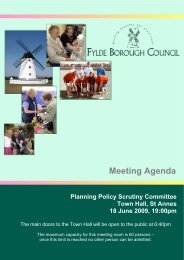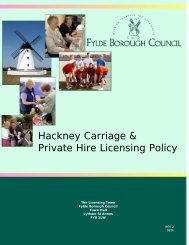Emergency Plan - Fylde Borough Council
Emergency Plan - Fylde Borough Council
Emergency Plan - Fylde Borough Council
You also want an ePaper? Increase the reach of your titles
YUMPU automatically turns print PDFs into web optimized ePapers that Google loves.
<strong>Emergency</strong> <strong>Plan</strong> February 2007<br />
8.1 Introduction<br />
As time goes on, the emphasis will switch from response to recovery. The emergency<br />
services will withdraw and the district or county council (dependent upon the nature of the<br />
emergency and recovery actions required) will generally take the lead role to facilitate the<br />
rehabilitation of the community and reconstruction and restoration of the environment. This is<br />
known as the recovery phase. It commences when the emergency services have dealt with<br />
the incident and there is no or little immediate threat to life. The transition from response to<br />
recovery may occur within hours, days or even weeks of the incident. Experience, however,<br />
has shown that the key to success lies in establishing the structure, make-up and roles of the<br />
Recovery Group as soon as possible during the operational phase of the incident.<br />
The recovery phase encompasses the activities necessary to restore ‘normality’ both for the<br />
community and for those involved in the response. Organisations and communities need to<br />
plan, manage and undertake those activities that will provide as rapid a return to normality as<br />
possible – for both the community and the responders. The incident and its effects may create<br />
a new “normality” raising serious issues for the local authority.<br />
Recovery encompasses the physical, social, psychological, political and financial<br />
consequences of an incident. This period can be labour intensive and may stretch the local<br />
authority to extraordinary levels. Consideration of recovery should be part of day-to-day<br />
emergency management. Anticipation of consequences and appropriate recovery planning<br />
must start right from the beginning of the emergency response as poor recovery management<br />
can undermine the benefit of a perceived good response.<br />
8.2 Recovery Co-ordination Group<br />
The <strong>Council</strong> or County <strong>Council</strong> will generally lead the recovery process after the emergency<br />
services have left the scene. To ensure there is no duplication of effort, agencies need to be<br />
brought together to discuss priorities for action. A multi-agency Recovery Co-ordination Group<br />
will normally be established to identify priorities on which utilities, private companies,<br />
voluntary agencies and the community may be represented. The <strong>Council</strong> may, however, also<br />
establish its own internal recovery group.<br />
There are many key issues that the co-ordination group will need to progress including: -<br />
• Strategies for delivering normal services<br />
• Reallocation of senior staff responsibilities<br />
• Establishing specialist sub-groups for long term recovery<br />
• Long term pressures on housing<br />
• Implications of and solutions to lack of resources<br />
• Implementing mutual aid arrangements<br />
• Comprehensive liaison<br />
• Focus for decisions on appeals, memorials and anniversaries<br />
• Assistance to local businesses<br />
8.3 Rebuilding the Community<br />
The physical reconstruction and restoration of services needs to be managed effectively. The<br />
authority may be under considerable pressure to restore any services interrupted as a result<br />
of an incident. The public will accept and make allowances for a period of disruption whilst the<br />
response is ongoing. However, public expectation will rise as time progresses and there will<br />
be pressure to restore services to demonstrate the authority is coping, thereby, enhancing<br />
public confidence.<br />
8.4 Physical Reconstruction<br />
Immediate attention will have been given to the safety and integrity of any structures affected<br />
by the incident during the response phase. There will be many individuals, departments and<br />
Section 8<br />
36<br />
Uncontrolled if Printed<br />
Rev.0
















